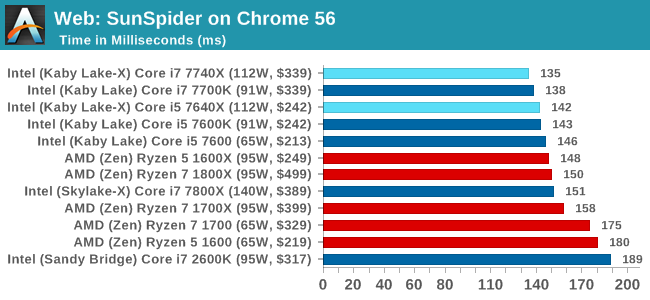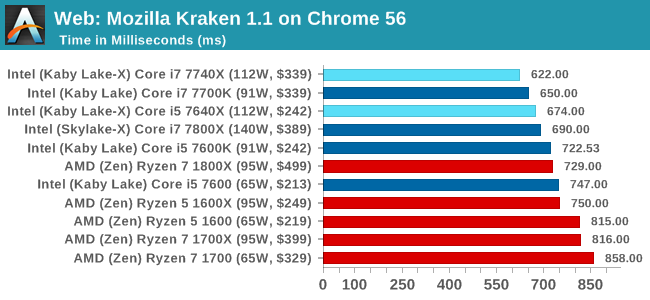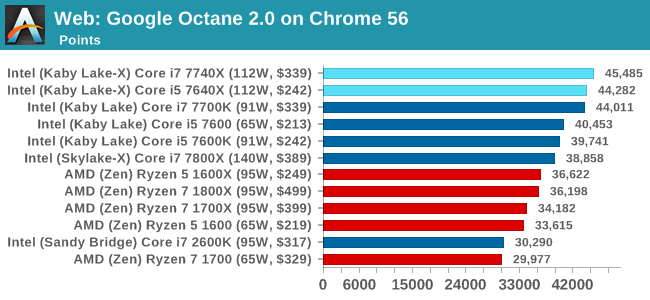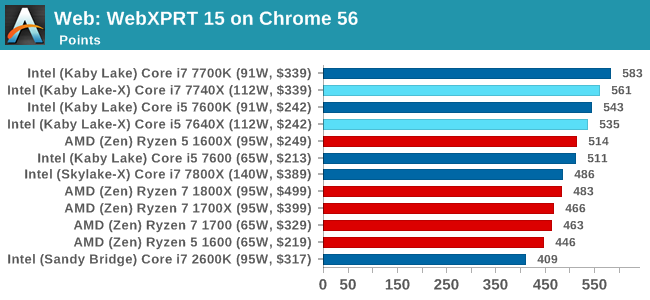The Intel Kaby Lake-X i7 7740X and i5 7640X Review: The New Single-Threaded Champion, OC to 5GHz
by Ian Cutress on July 24, 2017 8:30 AM EST- Posted in
- CPUs
- Intel
- Kaby Lake
- X299
- Basin Falls
- Kaby Lake-X
- i7-7740X
- i5-7640X
Benchmarking Performance: CPU Web Tests
One of the issues when running web-based tests is the nature of modern browsers to automatically install updates. This means any sustained period of benchmarking will invariably fall foul of the 'it's updated beyond the state of comparison' rule, especially when browsers will update if you give them half a second to think about it. Despite this, we were able to find a series of commands to create an un-updatable version of Chrome 56 for our 2017 test suite. While this means we might not be on the bleeding edge of the latest browser, it makes the scores between CPUs comparable.
All of our benchmark results can also be found in our benchmark engine, Bench.
SunSpider 1.0.2: link
The oldest web-based benchmark in this portion of our test is SunSpider. This is a very basic javascript algorithm tool, and ends up being more a measure of IPC and latency than anything else, with most high-performance CPUs scoring around about the same. The basic test is looped 10 times and the average taken. We run the basic test 4 times.

SunSpider has a single threaded focus, and we see the Kaby Lake-X processors take their spots at the top of the graph.
Mozilla Kraken 1.1: link
Kraken is another Javascript based benchmark, using the same test harness as SunSpider, but focusing on more stringent real-world use cases and libraries, such as audio processing and image filters. Again, the basic test is looped ten times, and we run the basic test four times.

Mozilla too relies on single threaded IPC and frequency.
Google Octane 2.0: link
Along with Mozilla, as Google is a major browser developer, having peak JS performance is typically a critical asset when comparing against the other OS developers. In the same way that SunSpider is a very early JS benchmark, and Kraken is a bit newer, Octane aims to be more relevant to real workloads, especially in power constrained devices such as smartphones and tablets.

Octane is an interesting benchmark, requiring cores and ST performance, but mostly the latter. It also seems that either Intel's design is optimized for the benchmark or vice versa, given the substantial difference in performance. There's no way for the benchmark to use all of the threads from AMD, nor the 12 threads in the Core i7-7800X which has a lower single thread performance.
WebXPRT 2015: link
While the previous three benchmarks do calculations in the background and represent a score, WebXPRT is designed to be a better interpretation of visual workloads that a professional user might have, such as browser based applications, graphing, image editing, sort/analysis, scientific analysis and financial tools.

WebXPRT is a mix of ST and MT, but still based in the web and relies on ST performance a lot. Given the variable loading on the benchmark, Intel's newest features such as Speed Shift help keep it at the top.










176 Comments
View All Comments
mapesdhs - Monday, July 24, 2017 - link
Let the memes collide, focus the memetic radiation, aim it at IBM and get them to jump into the x86 battle. :Ddgz - Monday, July 24, 2017 - link
Man, I could really use an edit button. my brain has shit itselfmapesdhs - Monday, July 24, 2017 - link
Have you ever posted a correction because of a typo, then realised there was a typo in the correction? At that point my head explodes. :DGlock24 - Monday, July 24, 2017 - link
"The second is for professionals that know that their code cannot take advantage of hyperthreading and are happy with the performance. Perhaps in light of a hyperthreading bug (which is severely limited to minor niche edge cases), Intel felt a non-HT version was required."This does not make any sense. All motherboards I've used since Hyper Threading exists (yes, all the way back to the P4) lets you disable HT. There is really no reason for the X299 i5 to exist.
Ian Cutress - Monday, July 24, 2017 - link
Even if the i5 was $90-$100 cheaper? Why offer i5s at all?yeeeeman - Monday, July 24, 2017 - link
First interesting point to extract from this review is that i7 2600K is still good enough for most gaming tasks. Another point that we can extract is that games are not optimized for more than 4 core so all AMD offerings are yet to show what they are capable of, since all of them have more than 4 cores / 8 threads.I think single threading argument absolute performance argument is plain air, because the differences in single thread performance between all top CPUs that you can currently buy is slim, very slim. Kaby Lake CPUs are best in this just because they are sold with high clocks out of the box, but this doesn't mean that if AMD tweaks its CPUs and pushes them to 5Ghz it won't get back the crown. Also, in a very short time there will be another uArch and another CPU that will have again better single threaded performance so it is a race without end and without reason.
What is more relevant is the multi-core race, which sooner or later will end up being used more and more by games and software in general. And when games will move to over 4 core usage then all these 4 cores / 8 threads overpriced "monsters" will become useless. That is why I am saying that AMD has some real gems on their hands with the Ryzen family. I bet you that the R7 1700 will be a much better/competent CPU in 3 years time compared to 7700K or whatever you are reviewing here. Dirt cheap, push it to 4Ghz and forget about it.
Icehawk - Monday, July 24, 2017 - link
They have been saying for years that we will use more cores. Here we are almost 20 years down the road and there are few non professional apps and almost no games that use more than 4 cores and the vast majority use just two. Yes, more cores help with running multiple apps & instances but if we are just looking at the performance of the focused app less cores and more MHz is still the winner. From all I have read the two issues are that not everything is parallelizable and that coding for more cores/threads is more difficult and neither of those are going away.mapesdhs - Monday, July 24, 2017 - link
Thing is, until now there hasn't been a mainstream-affordable solution. It's true that parallel coding requires greater skill, but that being the case then the edu system should be teaching those skills. Instead the time is wasted on gender studies nonsense. Intel could have kick started this whole thing years ago by releasing the 3930K for what it actually was, an 8-core CPU (it has 2 cores disabled), but they didn't have to because back then AMD couldn't even compete with mid-range SB 2500K (hence why they never bothered with a 6-core for mainstream chipsets). One could argue the lack of market sw evolvement to exploit more cores is Intel's fault, they could have helped promote it a long time ago.cocochanel - Tuesday, July 25, 2017 - link
+1!!!twtech - Monday, July 24, 2017 - link
What can these chips do with a nice watercooling setup, and a goal of 24x7 stability? Maybe 4.7? 4.8?These seem like pretty moderate OCs overall, but I guess we were a bit spoiled by Sandy Bridge, etc., where a 1GHz overclock wasn't out of the question.